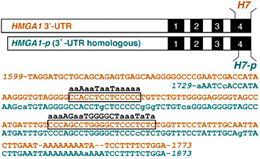Research Abstract
偽遺伝子が仲介するHMGA1の転写後サイレンシングはインスリン抵抗性と2型糖尿病を生じることがある
本論文では、HMGA1 mRNA不安定化がHMGA1偽遺伝子の1つであるHMGA1-pからのRNA発現上昇によって引き起こされることを示す。
Pseudogene-mediated posttranscriptional silencing of HMGA1 can result in insulin resistance and type 2 diabetes
2010年7月27日 Nature Communications 1 : 40 doi: 10.1038/ncomms1040

プロセス型偽遺伝子は、mRNAのレトロ転位過程によって生じ、正常な遺伝子とそっくりだが、機能をもつ産物をコードしていない。ヒトゲノムには数千の偽 遺伝子が含まれるが、その生物学的役割についての知識はまだ限られている。我々は以前、高速移動群タンパク質A1(HMGA1)がインスリン受容体遺伝子 (INSR)を調節していること、また2人の糖尿病患者でHMGA1 mRNAの顕著な不安定化がみられることを明らかにした。本論文では、このHMGA1 mRNA不安定化がHMGA1偽遺伝子の1つであるHMGA1-pからのRNA発現上昇によって引き起こされることを示す。患者由来細胞でHMGA1-p mRNAを選択的にノックダウンすると、HMGA1 mRNAの安定性と発現レベルがそれに比例して上昇し、これに対応して細胞表面でのINSR発現およびインスリン結合も正常化した。これらのデータは、ヒトでは発現された偽遺伝子が調節的役割を果たすことの証拠となり、また、偽遺伝子HMGA1-p発現と2型糖尿病の間の機構的つながりを確証している。
- カタンザーロ大学(伊)
Processed pseudogenes are non-functional copies of normal genes that arise by a process of mRNA retrotransposition. The human genome contains thousands of pseudogenes; however, knowledge regarding their biological role is limited. Previously, we demonstrated that high mobility group A1 (HMGA1) protein regulates the insulin receptor (INSR) gene and that two diabetic patients demonstrated a marked destabilization of HMGA1 mRNA. In this paper we report that this destabilization of HMGA1 mRNA is triggered by enhanced expression of RNA from an HMGA1 pseudogene, HMGA1-p. Targeted knockdown of HMGA1-p mRNA in patient cells results in a reciprocal increase in HMGA1 mRNA stability and expression levels with a parallel correction in cell-surface INSR expression and insulin binding. These data provide evidence for a regulatory role of an expressed pseudogene in humans and establishes a novel mechanistic linkage between pseudogene HMGA1-p expression and type 2 diabetes mellitus.

